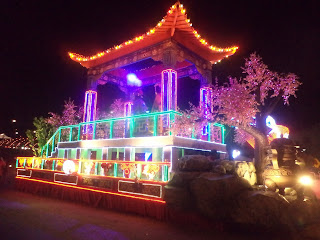I caught the Air India flight at 9am in the morning from Singapore for Delhi then changed
planes for the flight to London. In Delhi I was a bit surprised to be offered a
wheelchair to go to the transfer lounge then on the flight to London to be
treated as 'old' being covered by the flight attendant with two blankets as she
said that I was cold. Being 'old' with my sight failing (cue the violins) I sometimes have trouble making out the signs for the
toilets, the normal silhouettes for ladies and gentlemen, but there could be no mistake
in Delhi Airport with the large pictures at each toilet.
On the flight to London I took a photograph of the sunset that evening as I expected that it would be the last sunset I would see for quite a while.
That was the end of a 10 month trip, 28 weeks with Madventure/UKTOOZ and the remainder wandering round by myself and sometimes visiting friends in Australia. I have been asked if I have favourite place and the answer is No! There have been places I have enjoyed visiting such as Turkey for it's ruins and Istanbul (no ruins there) in particular; Iran, especially Esfahan, and the people of Iran who were very friendly; Pakistan for the wildness of the country and the friendliness of the people; India, Nepal and Thailand I have always enjoyed even when the hotel guests in Varanasi asked if the camp site on the hotel lawn was for refugees while it was some of the group camping there; Laos and Cambodia seemed to be slow, gentle places but Cambodia had the unforgettable Killing Fields and jails ; Vietnam full of contrasts with the American dollar as currency and with the Vietcong tunnels and the Vietnam War still being celebrated there; Singapore was not as I remembered it and I preferred it as it was years ago; Indonesia was fantastic with so much of a variety of temples, countryside and the amazing Komodo dragons; and Australia was expensive. I did side trips to Burma (it may still be called that though it has been renamed Myanmar) and Papua New Guinea. Burma and its temples were mind blowing, Papua New Guinea had changed considerably since we lived there as a family. I enjoyed going back and seeing the changes but I was very lucky in that I was looked after by the local people I had worked with before, which made travelling round much easier.
There was no preferred place out of all that I had visited. Different places had different attractions but there was one I would never want to visit again, which is Dharamsala in India. I know India was hot, smelly and full of people but that is what I expect in India. However, Dharamsala was so dirty that it was beyond the pale and that is where the Dalai Lama lives. Another question was if I felt threatened at any time. This was a difficult question to answer as although I considered Pakistan to be a dangerous country and with the police escort saying that it was too dangerous for us to be there I did not actually feel threatened, strange though it may seem. The local people in Quetta were quick to tell the group of Taliban we saw to go away as they wanted nothing to do with them and that was reassuring in itself. While out in the countryside we were an obvious target in a big orange truck. That was disconcerting.
Would I do another trip like this. At the moment I do not know. Maybe you can ask Mary!!
.JPG) |
| Gentlemen |
 |
| Ladies |
On the flight to London I took a photograph of the sunset that evening as I expected that it would be the last sunset I would see for quite a while.
There was no preferred place out of all that I had visited. Different places had different attractions but there was one I would never want to visit again, which is Dharamsala in India. I know India was hot, smelly and full of people but that is what I expect in India. However, Dharamsala was so dirty that it was beyond the pale and that is where the Dalai Lama lives. Another question was if I felt threatened at any time. This was a difficult question to answer as although I considered Pakistan to be a dangerous country and with the police escort saying that it was too dangerous for us to be there I did not actually feel threatened, strange though it may seem. The local people in Quetta were quick to tell the group of Taliban we saw to go away as they wanted nothing to do with them and that was reassuring in itself. While out in the countryside we were an obvious target in a big orange truck. That was disconcerting.
Would I do another trip like this. At the moment I do not know. Maybe you can ask Mary!!





.JPG)


























































